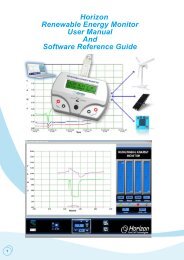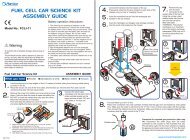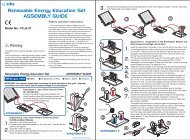2000W Fuel Cell Stack - Arcola Energy - Home
2000W Fuel Cell Stack - Arcola Energy - Home
2000W Fuel Cell Stack - Arcola Energy - Home
Create successful ePaper yourself
Turn your PDF publications into a flip-book with our unique Google optimized e-Paper software.
1.5 Flammability and volatilityHydrogen is flammable over concentrations of 4 – 75% by volume in air, and is explosive overconcentrations of 15 – 59%. As a result, even small leaks of hydrogen have the potential to burn orexplode. Leaked hydrogen can concentrate in an enclosed environment, thereby increasing the risk ofcombustion and explosion.Hydrogen lames are pale blue and are almost invisible in daylight due to the absence of soot. Due toits high buoyancy and diffusivity, burning hydrogen rises unlike gasoline, which spreads laterally.A lammable or explosive hydrogen mixture is easily ignited by a spark or even a hot surface. The autoignitiontemperature of hydrogen is 500 °C (932 °F). The energy of a hydrogen gas explosion is 2.4times that of gasoline or methane for an equal volume. Hydrogen gas explosions are therefore moredestructive and carry further.WARNING!A mixture of hydrogen and air is potentially lammable and explosive and can be ignited by a spark or ahot surface.As in the presence of any fuel, all sources of ignition, including smoking, are not permitted in the vicinityof the stack.WARNING!Keep all sources of ignition away. Smoking is not permitted in the vicinity of the stack.1.6 Oxygen DepletionOxygen is a colourless, odourless, non-toxic and tasteless gas. Oxygen is essential for life inappropriate concentrations.Ambient air contains up to 21% oxygen. Oxygen levels below 19.5% are biologically inactive andmay act as simple asphyxiants. Effects of oxygen deiciency may include: rapid breathing, diminishedmental alertness, impaired muscular coordination, faulty judgement, depression of all sensations,emotional instability, and fatigue. As asphyxiation progresses, nausea, vomiting, prostration, and lossof consciousness may result, eventually leading to convulsions, coma, and death. At concentrationsbelow 12%, immediate unconsciousness may occur with no prior warning symptoms.WARNING!Lack of oxygen can lead to unconsciousness and asphyxiation.As a preventative measure, the stack must be operated in a well-ventilated area in order to compensatefor the oxygen used within the fuel cells.WARNING!Always operate the stack in a well-ventilated area.H-2000 <strong>Fuel</strong> <strong>Cell</strong> <strong>Stack</strong> User Manual V2.63







